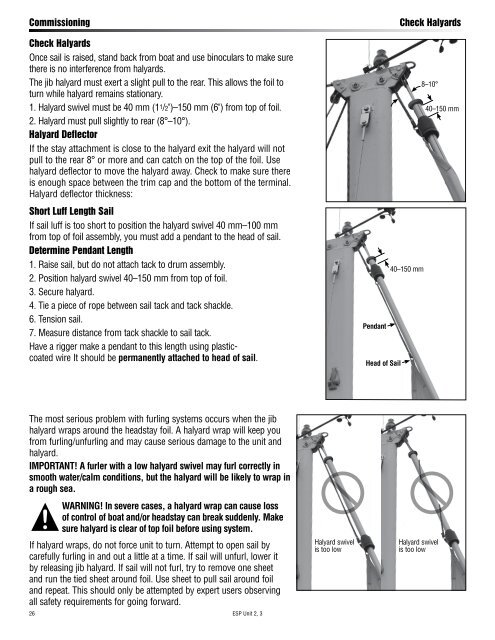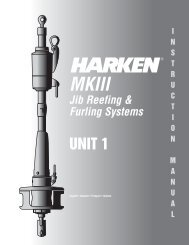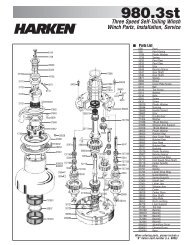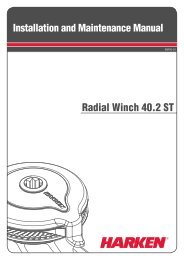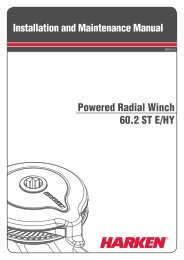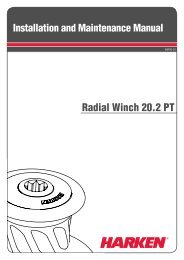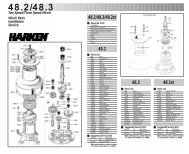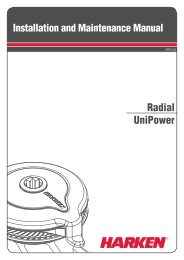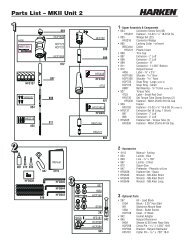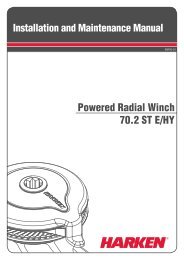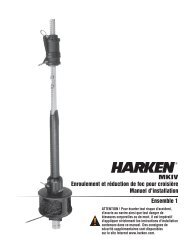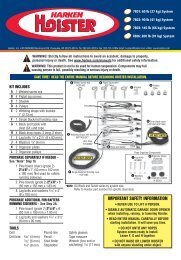ESP Jib REEfing & fuRling unit 1, 2, 3 - Harken
ESP Jib REEfing & fuRling unit 1, 2, 3 - Harken
ESP Jib REEfing & fuRling unit 1, 2, 3 - Harken
You also want an ePaper? Increase the reach of your titles
YUMPU automatically turns print PDFs into web optimized ePapers that Google loves.
Commissioning<br />
Check Halyards<br />
Once sail is raised, stand back from boat and use binoculars to make sure<br />
there is no interference from halyards.<br />
The jib halyard must exert a slight pull to the rear. This allows the foil to<br />
turn while halyard remains stationary.<br />
1. Halyard swivel must be 40 mm (1 1 /2")–150 mm (6") from top of foil.<br />
2. Halyard must pull slightly to rear (8°–10°).<br />
Halyard Deflector<br />
If the stay attachment is close to the halyard exit the halyard will not<br />
pull to the rear 8° or more and can catch on the top of the foil. Use<br />
halyard deflector to move the halyard away. Check to make sure there<br />
is enough space between the trim cap and the bottom of the terminal.<br />
Halyard deflector thickness:<br />
Short Luff Length Sail<br />
If sail luff is too short to position the halyard swivel 40 mm–100 mm<br />
from top of foil assembly, you must add a pendant to the head of sail.<br />
Determine Pendant Length<br />
1. Raise sail, but do not attach tack to drum assembly.<br />
2. Position halyard swivel 40–150 mm from top of foil.<br />
3. Secure halyard.<br />
4. Tie a piece of rope between sail tack and tack shackle.<br />
6. Tension sail.<br />
7. Measure distance from tack shackle to sail tack.<br />
Have a rigger make a pendant to this length using plasticcoated<br />
wire It should be permanently attached to head of sail.<br />
Check Halyards<br />
8–10°<br />
40–150 mm<br />
40–150 mm<br />
Pendant<br />
Head of Sail<br />
The most serious problem with furling systems occurs when the jib<br />
halyard wraps around the headstay foil. A halyard wrap will keep you<br />
from furling/unfurling and may cause serious damage to the <strong>unit</strong> and<br />
halyard.<br />
IMPORTANT! A furler with a low halyard swivel may furl correctly in<br />
smooth water/calm conditions, but the halyard will be likely to wrap in<br />
a rough sea.<br />
WARNING! In severe cases, a halyard wrap can cause loss<br />
of control of boat and/or headstay can break suddenly. Make<br />
sure halyard is clear of top foil before using system.<br />
If halyard wraps, do not force <strong>unit</strong> to turn. Attempt to open sail by<br />
carefully furling in and out a little at a time. If sail will unfurl, lower it<br />
by releasing jib halyard. If sail will not furl, try to remove one sheet<br />
and run the tied sheet around foil. Use sheet to pull sail around foil<br />
and repeat. This should only be attempted by expert users observing<br />
all safety requirements for going forward.<br />
26 <strong>ESP</strong> Unit 2, 3<br />
Halyard swivel<br />
is too low<br />
Halyard swivel<br />
is too low


